Stanford researches may have solved the problem of range anxiety by wireless charging technology that could one day create an electric highway.
Wireless recharging already is used by some electric vehicle charging stations to fill up batteries without cords or plugging into an outlet. MIT helped pioneer this technology and spun it off into a wireless charging startup, WiTricity. However, Stanford researchers improved on this concept and devised a way to transmit 10 kilowatts of electric power across a 6.5-foot distance with minimal energy loss. By overcoming transmitting electricity across a significant distance, researchers will make it possible to pave a highway with wireless conduits that can provide addition power to EVs and let them operate indefinitely.

Theoretically, coils bent at a 90-degree angle can be embedded in asphalt roads and attached to the electrical grid. Cars would be outfitted with identical coils attached to their undercarriage to create a magnetic field with the electric highway, which would wirelessly transmit electricity to keep the cars running.
This charging strategy has only been proven in Stanford’s computer models, but the results are promising. Computer simulations show a power transfer efficiency of 97 percent even at more than 6 feet range. Stationary wireless charging technology is typically 10 percent less efficient than corded energy transfer.
However, additional studies need to be performed to prove that this technology, even if feasible, won’t harm or interfere with people or other electrical systems and ensure that electricity is lost as heat and not radiation.
The technology could also play a role in autonomous vehicles. Magnetic fields created by wireless charging could be used to control steering and ensure vehicles stay in the lane.
(Source)
(Source)

 Follow
Follow